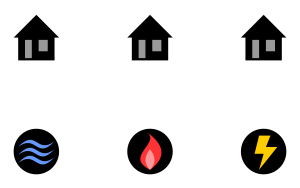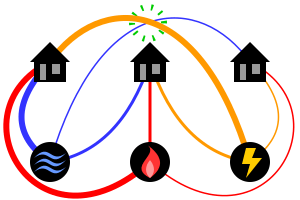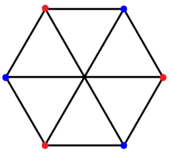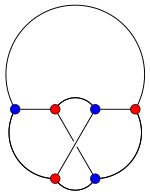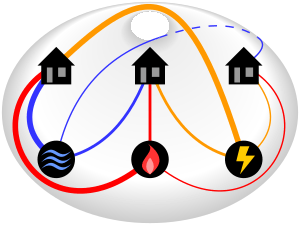Three utilities problem facts for kids
The classical mathematical puzzle known as the three utilities problem; the three cottages problem or sometimes water, gas and electricity can be stated as follows:
Suppose there are three cottages on a plane (or sphere) and each needs to be connected to the water, gas, and electricity companies. Without using a third dimension or sending any of the connections through another company or cottage, is there a way to make all nine connections without any of the lines crossing each other?
The problem is an abstract mathematical puzzle which imposes constraints that would not exist in a practical engineering situation. It is part of the mathematical field of topological graph theory which studies the embedding of graphs on surfaces. In more formal graph-theoretic terms, the problem asks whether the complete bipartite graph K3,3 is planar. This graph is often referred to as the utility graph in reference to the problem; it has also been called the Thomsen graph.
Solution

As it is usually presented (on a flat two-dimensional plane), the solution to the utility puzzle is "no": there is no way to make all nine connections without any of the lines crossing each other. In other words, the graph K3,3 is not planar. Kazimierz Kuratowski stated in 1930 that K3,3 is nonplanar, from which it follows that the problem has no solution. Kullman, however, states that "Interestingly enough, Kuratowski did not publish a detailed proof that [ K3,3 is ] non-planar".
One proof of the impossibility of finding a planar embedding of K3,3 uses a case analysis involving the Jordan curve theorem. In this solution, one examines different possibilities for the locations of the vertices with respect to the 4-cycles of the graph and shows that they are all inconsistent with a planar embedding.
Alternatively, it is possible to show that any bridgeless bipartite planar graph with V vertices and E edges has E ≤ 2V − 4 by combining the Euler formula V − E + F = 2 (where F is the number of faces of a planar embedding) with the observation that the number of faces is at most half the number of edges (the vertices around each face must alternate between houses and utilities, so each face has at least four edges, and each edge belongs to exactly two faces). In the utility graph, E = 9 and 2V − 4 = 8, violating this inequality, so the utility graph cannot be planar.
Generalizations
Two important characterizations of planar graphs, Kuratowski's theorem that the planar graphs are exactly the graphs that contain neither K3,3 nor the complete graph K5 as a subdivision, and Wagner's theorem that the planar graphs are exactly the graphs that contain neither K3,3 nor K5 as a minor, make use of and generalize the non-planarity of K3,3.
K3,3 is a toroidal graph, which means it can be embedded without crossings on a torus. In terms of the three cottage problem this means the problem can be solved by punching two holes through the plane (or the sphere) and connecting them with a tube. This changes the topological properties of the surface and using the tube allows the three cottages to be connected without crossing lines. An equivalent statement is that the graph genus of the utility graph is one, and therefore it cannot be embedded in a surface of genus less than one. A surface of genus one is equivalent to a torus. A toroidal embedding of K3,3 may be obtained by replacing the crossing by a tube, as described above, in which the two holes where the tube connects to the plane are placed along one of the crossing edges on either side of the crossing. Another way of changing the rules of the puzzle is to allow utility lines to pass through the cottages or utilities; this extra freedom allows the puzzle to be solved.
Pál Turán's "brick factory problem" asks more generally for a formula for the minimum number of crossings in a drawing of the complete bipartite graph Ka,b in terms of the numbers of vertices a and b on the two sides of the bipartition. The utility graph K3,3 may be drawn with only one crossing, but not with zero crossings, so its crossing number is one.
Other graph-theoretic properties
The utility graph K3,3 is a circulant graph. It is the (3,4)-cage, the smallest triangle-free cubic graph. Like all other complete bipartite graphs, it is a well-covered graph, meaning that every maximal independent set has the same size. In this graph, the only two maximal independent sets are the two sides of the bipartition, and obviously they are equal. K3,3 is one of only seven 3-regular 3-connected well-covered graphs.
It is also a Laman graph, meaning that it forms a minimally rigid system when it is embedded (with crossings) in the plane. It is the smallest example of a nonplanar Laman graph, as the other minimal nonplanar graph, K5, is not minimally rigid.
- Eric W. Weisstein, Utility graph at MathWorld.
See also
 In Spanish: Problema de los tres servicios para niños
In Spanish: Problema de los tres servicios para niños


